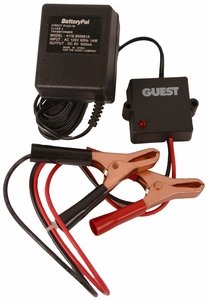I would like to keep the genset starting battery charged. Can anyone recommend a simple trickle charger that I can plug into AC when in slip so that my battery stats topped off? I have an outlet within 4 feet.
Suggestions?
What is keeping your main bank charged at the dock or is the main bank 24V, 32V, 36V etc.?
If you have an outlet/AC nearby I would suggest a good quality dry-mount charger with external temp sensor such as the Sterling ProCharge Ultra 10A. They are really not that much more expensive than some over priced "maintainers"..
If your other on-board batteries are 12V then a simple Echo Charger or ACR would work fine.
A "safe" float or maintenance charger is one that would have the
exact float voltage setting your battery requires or that features a user programmable setting. Most are one-size fits all over-priced snake oil & some can actually be bad for your batteries..
A good float or maintenance charger would also revert to a
gassing voltage (absorption) periodically, for flooded batteries, to prevent electrolyte stratification. Pulse charging can also work okay, if properly implemented, though it rarely limits electrolyte stratification. Avoid pulse-type maintainers if you have any parasitic loads that can trigger continual or frequently repeating absorption cycles.
Float or maintenance chargers are often misidentified as "trickle chargers" but trickle chargers, historically speaking, are constant current devices not constant voltage. Lifeline battery for example specifically prohibits the use of "trickle chargers"... Be sure what you are buying is not a "constant current" trickle charger.
"Trickle Charging:
Method of charging in which the battery is either continuously or intermittently connected to a constant current charging source to maintain the battery in a fully charged condition. Not recommended for use with Lifeline® AGM batteries."
A good safe unit would also have on-battery temp compensation not "near battery ambient " temp compensation, especially in an engine room. It would also have a zero or very near zero parasitic current for when power is lost and also have extremely low ripple. It would also pass UL 1236 & the UL 1236 "Marine Supplement".
The prices of some of these glorified snake-oil maintainers are absolutely offensive. Over $100.00 for .75A to 1.5A charger...?? Really?
If someone finds a quality float/maintenance charger please let me know. I have never seen one but I have seen a lot of BS marketing to make them
appear great......


